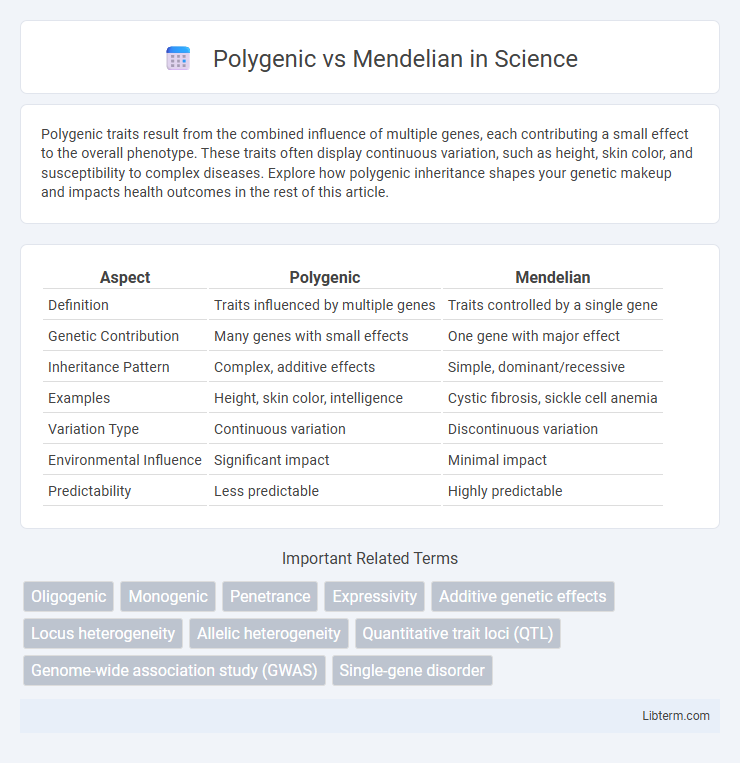Polygenic traits result from the combined influence of multiple genes, each contributing a small effect to the overall phenotype. These traits often display continuous variation, such as height, skin color, and susceptibility to complex diseases. Explore how polygenic inheritance shapes your genetic makeup and impacts health outcomes in the rest of this article.
Table of Comparison
| Aspect | Polygenic | Mendelian |
|---|---|---|
| Definition | Traits influenced by multiple genes | Traits controlled by a single gene |
| Genetic Contribution | Many genes with small effects | One gene with major effect |
| Inheritance Pattern | Complex, additive effects | Simple, dominant/recessive |
| Examples | Height, skin color, intelligence | Cystic fibrosis, sickle cell anemia |
| Variation Type | Continuous variation | Discontinuous variation |
| Environmental Influence | Significant impact | Minimal impact |
| Predictability | Less predictable | Highly predictable |
Introduction to Polygenic and Mendelian Inheritance
Mendelian inheritance involves traits controlled by a single gene with clear dominant or recessive alleles, following predictable patterns as first described by Gregor Mendel. Polygenic inheritance, in contrast, involves multiple genes contributing to a single trait, resulting in continuous variation such as height, skin color, or intelligence. Understanding the differences between Mendelian and polygenic inheritance is crucial for genetics, as it explains the complexity of many human traits beyond single-gene disorders.
Defining Mendelian Traits
Mendelian traits are characteristics controlled by a single gene with clear dominant or recessive alleles, resulting in distinct, predictable inheritance patterns described by Gregor Mendel's laws. These traits often follow simple inheritance patterns, where one gene variant directly determines a specific phenotype. In contrast, polygenic traits arise from the combined effect of multiple genes, leading to continuous variation rather than discrete categories.
Exploring Polygenic Traits
Polygenic traits result from the combined effect of multiple genes, each contributing a small influence to the phenotype, unlike Mendelian traits, which are controlled by a single gene with clear dominant or recessive patterns. Complex characteristics such as height, skin color, and susceptibility to many common diseases involve polygenic inheritance, where gene interactions and environmental factors produce continuous variation. Advances in genome-wide association studies (GWAS) have identified numerous genetic loci linked to polygenic traits, enhancing our understanding of their multifactorial nature and potential for personalized medicine.
Genetic Mechanisms: Mendelian vs Polygenic
Mendelian genetic mechanisms involve single-gene inheritance where traits are determined by alleles following dominant or recessive patterns, exemplified by conditions like cystic fibrosis or sickle cell anemia. Polygenic genetic mechanisms, however, are influenced by multiple genes, each contributing small effects that cumulatively affect complex traits such as height, skin color, or susceptibility to common diseases like diabetes and hypertension. These contrasting mechanisms highlight the simplicity of Mendelian loci versus the additive and interactive effects of numerous loci in polygenic inheritance.
Key Differences Between Mendelian and Polygenic Inheritance
Mendelian inheritance involves traits controlled by a single gene with clear dominant or recessive alleles, resulting in predictable inheritance patterns such as those described by Gregor Mendel's laws. Polygenic inheritance, in contrast, includes multiple genes contributing to a single trait, leading to continuous variation and complex phenotypes, such as height or skin color in humans. Mendelian traits typically follow discrete categories, while polygenic traits exhibit a spectrum influenced by gene interactions and environmental factors.
Examples of Mendelian Disorders
Mendelian disorders are caused by mutations in a single gene, following inheritance patterns first described by Gregor Mendel. Examples include cystic fibrosis, caused by mutations in the CFTR gene, and sickle cell anemia, resulting from a mutation in the HBB gene. These disorders typically exhibit clear dominant or recessive inheritance patterns, unlike polygenic traits influenced by multiple genes.
Examples of Polygenic Traits and Disorders
Polygenic traits, such as height, skin color, and eye color, result from the combined influence of multiple genes, contrasting with Mendelian traits governed by a single gene mutation. Common polygenic disorders include type 2 diabetes, heart disease, and schizophrenia, where gene-gene interactions and environmental factors contribute to disease risk. These complex traits demonstrate continuous variation and multifactorial inheritance, distinguishing them from the discrete phenotypes typical of Mendelian genetics.
Implications for Genetic Testing and Prediction
Polygenic traits involve multiple genes contributing small effects, complicating genetic testing and prediction compared to Mendelian traits, which are caused by single gene mutations with clearer inheritance patterns. Polygenic risk scores can estimate the likelihood of developing complex diseases but often lack the precision and certainty found in Mendelian testing. Understanding these differences is crucial for interpreting genetic test results and guiding personalized medicine strategies.
Impact on Personalized Medicine
Polygenic traits, influenced by multiple genes, complicate personalized medicine by requiring comprehensive genetic profiling to predict disease risk and drug response accurately. Mendelian disorders, caused by mutations in a single gene, allow for more straightforward genetic testing and targeted treatment strategies. Understanding the polygenic architecture enhances risk stratification models, while Mendelian genetics facilitates precise diagnostic and therapeutic interventions, together advancing personalized healthcare.
Future Directions in Genetic Research
Future directions in genetic research emphasize the integration of polygenic risk scores with Mendelian gene analysis to improve predictive accuracy and personalized medicine. Advances in machine learning and genome-wide association studies (GWAS) enable the identification of complex genetic interactions underlying common diseases beyond single-gene mutations. The convergence of large-scale biobank data and multi-omics approaches promises to uncover novel therapeutic targets, enhancing precision genomics and risk stratification strategies.
Polygenic Infographic

 libterm.com
libterm.com